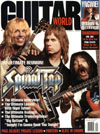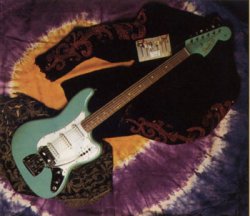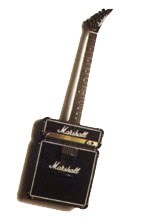 home // store // text
files
// multimedia // discography // a
to zed
// random
// links
home // store // text
files
// multimedia // discography // a
to zed
// random
// links
  "Don't touch it.! Don't
even point at it." Immortalized in the famous guitar-room
sequence of This Is Spinal Tap, Nigel Tufnel's foam-green Fender
6-string bass remains yet to be played. Vintage expert Norm Harris,
of Norm's Rare Guitars, to determines from the instrument's serial
number that it was made in 1966. He adds that, "It's an
odd one, because it has clay dot markers." According to
the authoritative American Guitars,
only 300 or 400 Bass VI's were made from the time of the model's
introduction in 1961 to the sale of Fender to CBS in '65. The
model was discontinued in 1975. "Don't touch it.! Don't
even point at it." Immortalized in the famous guitar-room
sequence of This Is Spinal Tap, Nigel Tufnel's foam-green Fender
6-string bass remains yet to be played. Vintage expert Norm Harris,
of Norm's Rare Guitars, to determines from the instrument's serial
number that it was made in 1966. He adds that, "It's an
odd one, because it has clay dot markers." According to
the authoritative American Guitars,
only 300 or 400 Bass VI's were made from the time of the model's
introduction in 1961 to the sale of Fender to CBS in '65. The
model was discontinued in 1975.
 Nigel is as cautious as ever
with his prize. He has the bass under round-the-clock surveillance
by an armed guard, and to this day resists the temptation to
plug it in. "It's kind of a Zen thing," he muses. "Playing
it would be kind of like unvirgining a virgin." Nigel is as cautious as ever
with his prize. He has the bass under round-the-clock surveillance
by an armed guard, and to this day resists the temptation to
plug it in. "It's kind of a Zen thing," he muses. "Playing
it would be kind of like unvirgining a virgin."
THE ANDERSONS
 Nigel does play his main guitars
— two Strat-style Tom Andersons [Tom Anderson Guitar
Works, 2697 Lavery Ct., Newbury Park, CA 91302] — a Nigel does play his main guitars
— two Strat-style Tom Andersons [Tom Anderson Guitar
Works, 2697 Lavery Ct., Newbury Park, CA 91302] — a
 bass
wood Pro Am, with two single-coils and a humbucker in the bridge
position and a lace wood Grand Am, with two humbuckers and a
single-coil in the middle. bass
wood Pro Am, with two single-coils and a humbucker in the bridge
position and a lace wood Grand Am, with two humbuckers and a
single-coil in the middle.
 "The models Nigel played
on the album," says Anderson, "were what we call 'test
units' — just unfinished guitars that we put together and
load out to people. He ended up keeping the bass wood Pro Am
model, which he's having painted, and for the tour he has ordered
a Grand Am in cherry sunburst and another Pro Am with a maple
top and rosewood fingerboard."' "The models Nigel played
on the album," says Anderson, "were what we call 'test
units' — just unfinished guitars that we put together and
load out to people. He ended up keeping the bass wood Pro Am
model, which he's having painted, and for the tour he has ordered
a Grand Am in cherry sunburst and another Pro Am with a maple
top and rosewood fingerboard."'
 Along with the Andersons,
Nigel used some of his finest guitars on Break Like The Wind:
his 1946 herringbone Martin D-28, Coral Electric Sitar (both
on "Clam Caravan"), Guild 12-string ("Just Begin
Again"), Gibson Chet Atkins Solidbody Classical ("Break
Like The Wind"), and custom-made Tele ("The Majesty
Of Rock"). Along with the Andersons,
Nigel used some of his finest guitars on Break Like The Wind:
his 1946 herringbone Martin D-28, Coral Electric Sitar (both
on "Clam Caravan"), Guild 12-string ("Just Begin
Again"), Gibson Chet Atkins Solidbody Classical ("Break
Like The Wind"), and custom-made Tele ("The Majesty
Of Rock").
 On the 1961-recorded "All
The Way Home," Nigel played a Gretsch Chet Atkins (he doesn't
recall the type of amplifier), and on 1967's "Rainy Day
Sun" he played a Hofner Verythin through a Vox AC-30. He
recently switched to slightly heavier strings (D'Addario 10's)
on all electrics, and for his acoustics, he says, "I get
these Eclipse strings from Matt Umanov [273 Bleeker St., New
York, NY 10014]." On the 1961-recorded "All
The Way Home," Nigel played a Gretsch Chet Atkins (he doesn't
recall the type of amplifier), and on 1967's "Rainy Day
Sun" he played a Hofner Verythin through a Vox AC-30. He
recently switched to slightly heavier strings (D'Addario 10's)
on all electrics, and for his acoustics, he says, "I get
these Eclipse strings from Matt Umanov [273 Bleeker St., New
York, NY 10014]."
 For the upcoming tour, Tufnel
notes, "I was going to take 150 guitars on the road. About
28 acoustics, 35 Strats — different guitars for different
sounds and moods. But it caused a lot of unrest with the roadies,
whod'd have to keep them in tune. And just the guitar stands
alone cost quite a lot of money. So I've whittled it down to
about 50." When reminded that some of the greatest stylists
of all time always stuck to one model — James Burton, for
example, had his Telecaster, while Lonnie Mack had a FlyingV,
Nigel says, "I need the variety. It's like when you go to
a party. You talk to one person for a bit, then move on to another.
If you went to a party with just one guest, it'd get boring pretty
quickly. I don't know Mr. Mack, but I think in his case he just
doesn't know that there are any other guitars." For the upcoming tour, Tufnel
notes, "I was going to take 150 guitars on the road. About
28 acoustics, 35 Strats — different guitars for different
sounds and moods. But it caused a lot of unrest with the roadies,
whod'd have to keep them in tune. And just the guitar stands
alone cost quite a lot of money. So I've whittled it down to
about 50." When reminded that some of the greatest stylists
of all time always stuck to one model — James Burton, for
example, had his Telecaster, while Lonnie Mack had a FlyingV,
Nigel says, "I need the variety. It's like when you go to
a party. You talk to one person for a bit, then move on to another.
If you went to a party with just one guest, it'd get boring pretty
quickly. I don't know Mr. Mack, but I think in his case he just
doesn't know that there are any other guitars."
 Three amp rigs were used on
the new album: a Bogner-modified Marshall 800 (on the Dave Jerden-produced
tracks), Steve Lukather's VHT/Bradshaw rig (on the Luke-produced
cuts), and for the Danny Kortchmar-produced sides, the amp inspired
by Nigel himself, Marshall's JCM 900, which goes to 20. Three amp rigs were used on
the new album: a Bogner-modified Marshall 800 (on the Dave Jerden-produced
tracks), Steve Lukather's VHT/Bradshaw rig (on the Luke-produced
cuts), and for the Danny Kortchmar-produced sides, the amp inspired
by Nigel himself, Marshall's JCM 900, which goes to 20.
 Probably the most eye-catching
piece in the guitarist's arsenal is the custom-made Marshall
stack 6-string pictured on the cover of this issue. Also inspired
by Nigel, it was designed by Marshall's Mike Doyle and executed
by Probably the most eye-catching
piece in the guitarist's arsenal is the custom-made Marshall
stack 6-string pictured on the cover of this issue. Also inspired
by Nigel, it was designed by Marshall's Mike Doyle and executed
by  Jackson Guitars.
It features a maple neck-through-body design with bass wood sides
(and extension cabinet), ebony fretboard, 22 frets clear, and
one Seymour Duncan humbucker. All other parts — cabinet
corners, brass rivets, logos, control knobs, white piping, and
front and back control panels — are made by Marshall. The
"NT" is the only one of its kind — serial number
JMOO1. As Doyle points out, "It can be played in either
half-stack or full-stack configurations." What does the
added extension cabinet do? "What any extension cabinet
does," shrugs Nigel. "It makes it harder to pick up." Jackson Guitars.
It features a maple neck-through-body design with bass wood sides
(and extension cabinet), ebony fretboard, 22 frets clear, and
one Seymour Duncan humbucker. All other parts — cabinet
corners, brass rivets, logos, control knobs, white piping, and
front and back control panels — are made by Marshall. The
"NT" is the only one of its kind — serial number
JMOO1. As Doyle points out, "It can be played in either
half-stack or full-stack configurations." What does the
added extension cabinet do? "What any extension cabinet
does," shrugs Nigel. "It makes it harder to pick up."
|